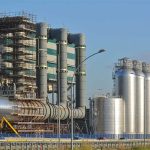Biomass is biological material derived from living, or recently living organisms. It most often refers to plants or plant-based materials which are specifically called lignocellulosic biomass. As an energy source, biomass can either be used directly via combustion to produce heat, or indirectly after converting it to various forms of biofuel. Conversion of biomass to biofuel can be achieved by different methods which are broadly classified into: thermal, chemical, and biochemical methods.
Wood remains the largest biomass energy source to date; examples include forest residues (such as dead trees, branches and tree stumps), yard clippings, wood chips and even municipal solid waste. In the second sense, biomass includes plant or animal matter that can be converted into fibers or other industrial chemicals, including biofuels. Industrial biomass can be grown from numerous types of plants, including miscanthus, switchgrass,hemp, corn, poplar, willow, sorghum, sugarcane, bamboo, and a variety of tree species, ranging from eucalyptus to oil palm (palm oil).

Plant energy is produced by crops specifically grown for use as fuel that offer high biomass output per hectare with low input energy. Some examples of these plants are wheat, which typically yield 7.5–8 tonnes of grain per hectare, and straw, which typically yield 3.5–5 tonnes per hectare in the UK. The grain can be used for liquid transportation fuels while the straw can be burned to produce heat or electricity. Plant biomass can also be degraded from cellulose to glucose through a series of chemical treatments, and the resulting sugar can then be used as a first generation biofuel.
Biomass can be converted to other usable forms of energy like methane gas or transportation fuels like ethanol and biodiesel. Rotting garbage, and agricultural and human waste, all release methane gas also called “landfill gas” or “biogas.” Crops, such as corn and sugar cane, can be fermented to produce the transportation fuel, ethanol. Biodiesel, another transportation fuel, can be produced from left-over food products like vegetable oils and animal fats. Also, biomass to liquids (BTLs) and cellulosic ethanol are still under research There is a great deal of research involving algal, or algae-derived, biomass due to the fact that it’s a non-food resource and can be produced at rates 5 to 10 times faster than other types of land-based agriculture, such as corn and soy. Once harvested, it can be fermented to produce biofuels such as ethanol, butanol, and methane, as well as biodiesel and hydrogen.
Municipal Waste
The composition of municipal solid waste varies greatly from municipality to municipality (country to country) and changes significantly with time. In municipalities (countries) which have a well-developed waste recycling culture, the waste stream consists mainly of intractable wastes such as plastic film, and un-recyclable packaging materials. At the start of the 20th century, the majority of domestic waste (53%) in the UK consisted of coal ash from open fires in developed municipalities (countries) without significant recycling activity it predominantly includes food wastes, market wastes, yard wastes, plastic containers and product packaging materials, and other miscellaneous solid wastes from residential, commercial, institutional, and industrial sources. Most definitions of municipal solid waste do not include industrial wastes, agricultural wastes, medical waste, radioactive waste or sewage sludge. Waste collection is performed by the municipality within a given area. The term residual waste relates to waste left from household sources containing materials that have not been separated out or sent for reprocessing. Waste can be classified in several ways but the following list represents a typical classification:
1. Biodegradable waste: food and kitchen waste, green waste, paper (can also be recycled).
2. Recyclable material: paper, glass, bottles, cans, metals, certain plastics, fabrics, clothes, batteries etc.
3. Inert waste: construction and demolition waste, dirt, rocks, debris.
4. Electrical and electronic waste (WEEE) – electrical appliances, TVs, computers, screens, etc.
5. Composite wastes: waste clothing, Tetra Packs, waste plastics such as toys.
6. Hazardous waste including most paints, chemicals, light bulbs, fluorescent tubes, spray cans, fertilizer and containers
7. Toxic waste including pesticide, herbicides, fungicides
8. Medical waste.


